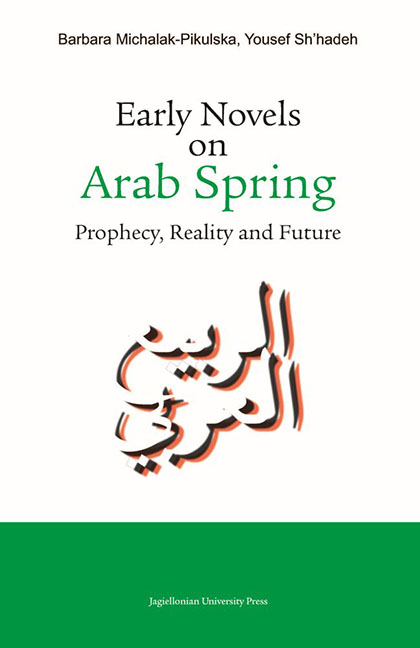Book contents
- Frontmatter
- Contents
- Introduction
- Part I Awakening of the Awareness of Subjugation – The Prophecy of the Spring of Nations in Arab Novels
- Part II At the Heart of the Arab Spring Events
- Part III The Future: The Spring Continues
- 17 Mu‘Taṣim Aš - Šā‘Ir : Uhzūǧat ar-raḥīl (A Song of Departure) and Fī intiẓār as-sulaḥfāt (Waiting for a Turtle)
- 18 Aḥmad ‘Abd Al - Malik : Al-Aqni‘a (Masks)
- 19 Ṭayba Aš - Šarīf Al - Idrīsī : Ḥaǧar min saqar (A Stone from Hell)
- 20 Amīra Aš - Širbīnī : ‘Itq (Liberation)
- 21 ‘ Izz Ad - Dīn Šukrī Fašīr : Bāb al-ẖurūǧ – risālat ‘Alī al-muf‘ama bi-bahǧa ġayr mutawaqqa‘a (The Gate to Leave – Ali’s Letter Filled with Unexpected Joy)
- Conclusion
- Bibliography
- Summary in Arabic
5 - Muḥammad Rabī‘: ‘Ām at-tinnīn (Year of the Dragon)
Published online by Cambridge University Press: 13 October 2023
- Frontmatter
- Contents
- Introduction
- Part I Awakening of the Awareness of Subjugation – The Prophecy of the Spring of Nations in Arab Novels
- Part II At the Heart of the Arab Spring Events
- Part III The Future: The Spring Continues
- 17 Mu‘Taṣim Aš - Šā‘Ir : Uhzūǧat ar-raḥīl (A Song of Departure) and Fī intiẓār as-sulaḥfāt (Waiting for a Turtle)
- 18 Aḥmad ‘Abd Al - Malik : Al-Aqni‘a (Masks)
- 19 Ṭayba Aš - Šarīf Al - Idrīsī : Ḥaǧar min saqar (A Stone from Hell)
- 20 Amīra Aš - Širbīnī : ‘Itq (Liberation)
- 21 ‘ Izz Ad - Dīn Šukrī Fašīr : Bāb al-ẖurūǧ – risālat ‘Alī al-muf‘ama bi-bahǧa ġayr mutawaqqa‘a (The Gate to Leave – Ali’s Letter Filled with Unexpected Joy)
- Conclusion
- Bibliography
- Summary in Arabic
Summary
The title already indicates that the plot of the work takes place in 2012, that is, in the year of the dragon. The novel balances between fantasy and reality, and between fiction and facts. The author shows the world of bureaucracy in Egypt by inventing stories full of satire and mockery that are populated by real and fictional characters. An example would be the presentation of a bureaucratic paradox when a man living and functioning in a society is considered dead in an “administrative machine.” This is the first novel in the history of Egyptian literature in which Hosni Mubarak is one of the characters. The work does not speak directly about the Egyptian revolution, but suggests the need for it. By the time the revolution came, the author already had a very advanced draft of the novel. He decided to suspend writing for some time and returned to it after the fall of the Mubarak regime.
The main character is Na‘īm Abū Sab‘a, who works in the book binding business. His life is a series of family and professional problems, so he decides to extort money from an insurance company by feigning his death. He needs the means to get out of extreme poverty and secure his family – by exploiting loopholes in the bureaucratic system and bribing officials, he hopes to get the death certificate needed for his plan to work.
The novel begins with a letter from an anonymous author. Further letters appear in subsequent chapters, also without a signature. Only at the end of the novel do we learn that their author has the same last name as the main character. The letters show that he held a high position and supported Mubarak’s rule. However, due to the unfortunate coincidence, it turned out that his name is the same as that of a man wanted by the security services as an enemy of the state. To avoid arrest, he is forced to hide.
- Type
- Chapter
- Information
- Early Novels on Arab SpringProphecy, Reality and Future, pp. 22 - 28Publisher: Jagiellonian University PressPrint publication year: 2022

